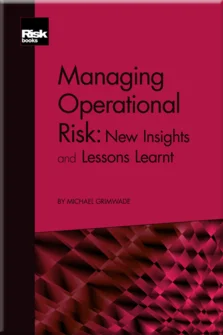Conclusions
Conclusions
Introduction
Three Historical Spikes in Operational Risk Losses
First-Order Effects: Transforming Credit Defaults and Market Turmoil into Operational Risk Losses
Second-Order Effects: Transforming Rising Unemployment and Falling Interest Rates into Operational Risk Losses
Conclusions and Root Causes
Regulatory Change: Part of a Perfect Storm
Macroeconomic Threats: Tax, Rising Interest Rates and New Asset Bubbles
New Technology: Changing Business Models and Risk Profiles
Three Horsemen: Societal, Political and Environmental Change
Backtesting to the Mid-1990s and Conclusions
Defining and Cascading Operational Risk Appetites
Aligning Operational Risk Management Frameworks to Appetites
Estimating Exposures to Tail Events
Solutions for a Triumvirate of Seemingly Intractable Problems
Conclusions
LESSONS LEARNT
The scope of operational risk ranges from day-to-day losses to large idiosyncratic events. Operational risk can also generate industry-wide losses, and it was these that were most prevalent during the global financial crisis. The analysis of case studies of these losses in the first part of this book highlighted that many of these losses arose as a result of a combination of:
-
- banks providing services, in return for fees, to customers and investors that often transferred to them market and credit risks;
-
- the global financial crisis, which led to those customers and investors suffering losses as a consequence of either rising credit defaults or market turmoil or falling interest rates; and
-
- misconduct by the firms, which essentially granted their customers and investors an option to sue if they suffered loss (misconduct by firms is the financial equivalent of the Philosophers Stone, ie, turning customers’ and investors’ market and credit risk losses into operational risk losses suffered by the banks).
The common failings within banks that led to these losses included poorly defined policies and procedures, inadequate
Copyright Infopro Digital Limited. All rights reserved.
As outlined in our terms and conditions, https://www.infopro-digital.com/terms-and-conditions/subscriptions/ (point 2.4), printing is limited to a single copy.
If you would like to purchase additional rights please email info@risk.net
Copyright Infopro Digital Limited. All rights reserved.
You may share this content using our article tools. As outlined in our terms and conditions, https://www.infopro-digital.com/terms-and-conditions/subscriptions/ (clause 2.4), an Authorised User may only make one copy of the materials for their own personal use. You must also comply with the restrictions in clause 2.5.
If you would like to purchase additional rights please email info@risk.net










